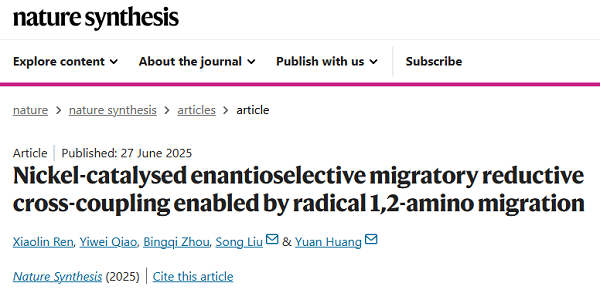Breakthrough by XJTU pharmacy team published in Nature Synthesis

Professor Huang's team publishes its research results in Nature Synthesis.
The chiral β-aryl ethylamine scaffold is a classic pharmacophore found in endogenous neurotransmitters, bioactive natural products, and pharmaceutical molecules, exhibiting broad pharmacological activities.
Although existing asymmetric catalytic techniques have advanced the synthesis of chiral β-aryl ethylamines, these methods typically rely on pre-functionalized nitrogen-containing π-activated substrates and yield limited structural diversity.
Consequently, developing a modular, stereospecific, and structurally diverse synthetic approach for chiral β-aryl ethylamines is of great importance. Such progress would expand the chemical and biological exploration of this scaffold, driving innovation in early-stage drug discovery.
Transition-metal-catalyzed migratory cross-coupling reactions, as powerful strategies for building carbon-carbon bonds, have achieved remarkable progress in recent years. Among these, nickel-catalyzed systems demonstrate exceptional advantages in the remote functionalization of alkyl electrophiles due to their unique reactivity.
However, two critical challenges persist in this field: (1) Research on cross-coupling reactions driven by heteroatom (especially nitrogen) group migration lags far behind well-established hydrogen-atom migration systems; (2) Existing methods face substantial difficulties in achieving stereoselective control, with asymmetric versions of heteroatom migratory coupling remaining virtually unreported.
Addressing these challenges, Professor Huang Yuan's team at Xi'an Jiaotong University's (XJTU) School of Pharmacy proposed a novel strategy: nickel-catalyzed radical 1,2-amino migration cascaded with reductive coupling.
Using readily available β-amino alcohol sulfonates as substrates, the team efficiently synthesized a series of chiral β-aryl ethylamine derivatives – key intermediates in pharmaceutical manufacturing – through reactions with alkyl sulfonates, alkenyl sulfonates/halides, or aryl halides.
This work integrates new reaction design, catalyst development, and mechanistic studies, not only revealing a novel mechanism for transition-metal nickel-catalyzed coupling chemistry but also resolving the challenge of precision synthesis for chiral β-aryl ethylamine derivatives.
This breakthrough is expected to provide essential synthetic methodologies and theoretical guidance for developing drugs containing this core scaffold (e.g., neuroactive and cardiovascular agents), demonstrating significant academic value and industrial potential.
These findings were published in the prestigious journal Nature Synthesis (impact factor: 20.0) under the title Nickel-catalyzed enantioselective migratory reductive cross-coupling enabled by radical 1,2-amino migration.

